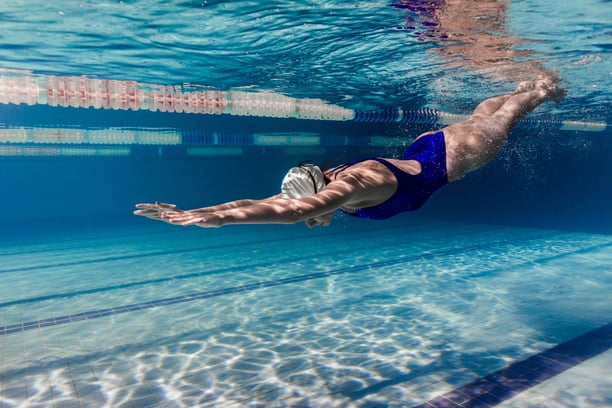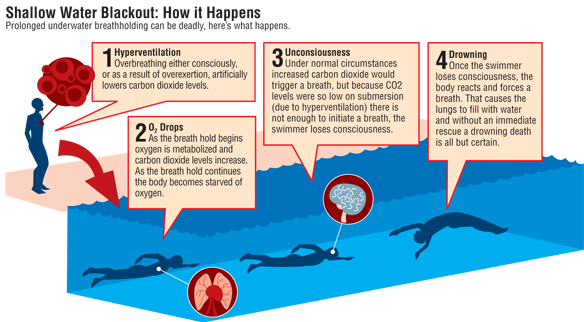
By Dr Joanna Chan Shi-En
Breath-Holding with Hyperventilation: An Invisible Danger
Breath-holding is sometimes seen as a gauge of fitness, and may be practised in various settings on land and in water by fitness enthusiasts, swimmers and divers. Trends like the Wim Hof method, popularised by the Dutch extreme athlete of that name, incorporate hyperventilation and breath holding in a breathing exercise touted to have beneficial effects.
Don’t Mix With Water!
As a technique to lengthen breath-holding, some people may take many fast breaths beforehand to increase the amount of time they can then spend holding their breath. This is known as hyperventilation or over-breathing.
Unknown to many, deliberate hyperventilation practised in the context of swimming or in the water can be deadly. It puts swimmers at risk of a phenomenon known as “Shallow Water Blackout” (hypoxic blackout), a common cause of drowning among competitive, advanced swimmers and divers (1,2). It is so named because many reports of this occur at less than 5m, although it can happen at any depth.
Hyperventilation exercises popularised by the Wim Hof method have led to deaths worldwide (3,4) when practised in or near bodies of water. The official Wim Hof website warns people not to use these breathing techniques near the water due to this risk.
How does Shallow Water Blackout (hypoxic blackout) occur?
The build-up of carbon dioxide (CO2) is what alerts our brain that we need to take a breath. Taking a series of fast breaths (hyperventilation) expels CO2 from the lungs, and lengthens the time till the brain tells the body that the next breath needs to be taken.
If hyperventilation is done prior to immersion in water, lower-than-normal CO2 levels in the swimmer’s blood means that the swimmer is not prompted to take a breath despite the fact that oxygen levels are being depleted through breath-holding and exercise. Once oxygen levels dip below the level needed to maintain consciousness, the swimmer faints without any warning as the urge to surface and breathe has been suppressed.
After fainting has occurred, CO2 levels build up and the unconscious swimmer takes a reflex breath while still underwater, leading to water entering the lungs (aspiration) or provoking a spasm of the airway. This begins the drowning process, and results in death unless the swimmer is observed to be in difficulty and rescued in a timely manner.
This loss of consciousness may be mistaken for a deliberate breath-holding exercise as there is no struggle or signs of distress. Drowning is hard to spot and rescue may be delayed. In reports from the 1970s, breath holding experiments indicated that the time between loss of consciousness and death may be no longer than 2.5 minutes, as in such cases the swimmer has already had a long period of breath-holding prior to falling unconscious and is already at risk of oxygen-deprivation injury (5).

Picture credit: Aquatics International, Nov/Dec 2011 Issue. Image from
http://www.shallowwaterblackoutprevention.org/
Keeping safe in the water
Shallow Water Blackout is known to occur with the following features of breath-holding:
- Hyperventilation.
- Competitive breath-holding, when the swimmer is competing with themselves or with friends in play or in the course of sport training or work, including military diving (1,2,5,6). The competitive nature of sports may lead to self-misjudgement of capabilities in highly trained swimmers, who are at risk.
- Repetitive prolonged breath-holding, whether static or concurrently with training activities, such as repetitive underwater laps in which the swimmer may not surface between laps (2,6).
The Shallow Water Blackout Prevention website recommends a ban on prolonged breath holding in pools for the general public and summarises safety recommendations as follows:
▪ Never hyperventilate.
▪ Never ignore the urge to breathe.
▪ Never swim alone.
▪ Never play breath-holding games.
▪ No repetitive underwater laps. One lap, breathe.
Article Contributed By:
Dr Joanna Chan Shi-En
Consultant
Dept of Emergency Medicine
Singapore General Hospital
Further education materials and videos
Shallow Water Blackout Prevention is a non-profit organisation started in 2011 by the family of Gene “Whitner” Milner, to raise awareness of the dangers of hyperventilation and prolonged breath holding after the death of 25-year-old Whitner in his own backyard pool while practising breath holding for spear-fishing. See the website (http://www.shallowwaterblackoutprevention.org/) for more resources, including signage, teaching aids and videos.
References:
(1) Bart RM, Lau H. (August 1, 2021.) Shallow Water Blackout. In Editor. StatPearls. StatPearls Publishing. Retrieved on August 24, 2021.
(2) Boyd C, Levy A, McProud T et al. Fatal and Nonfatal Drowning Outcomes Related to Dangerous Underwater Breath-Holding Behaviors — New York State, 1988–2011. MMWR Morb Mortal Wkly Rep. 2015 May 22; 64(19): 518-521.
(3) Jan Duin R (Jul 2 2016). Het Parool. 'Iceman'-oefening eist opnieuwleven. https://www.parool.nl/nieuws/iceman-oefening-eist-opnieuw-leven~bd0a4600/ Retrieved on August 24, 2021.
(4) Drowning death claims Sacramento yoga instructor (August 4, 2017). Penney & Associates Injury Lawyers. https://www.penneylawyers.com/serious-injuries/drowning-death-claims-sacramento yoga-instructor/ Retrieved on August 24, 2021.
(5) A B Craig Jr. Summary of 58 cases of loss of consciousness during underwater swimming and diving. Med Sci Sports. Fall 1976;8(3):171-5.
(6) Szpilman D, Orlowski JP. Sports related to drowning. Eur Respir Rev. 2016 Sep;25(141):348-59.





![ActiveSG Academies and Clubs Logo (Solid Colour)[8647]](https://www.activesgcircle.gov.sg/hs-fs/hubfs/ActiveSG%20Circle%202023Theme/images/ActiveSG%20Academies%20and%20Clubs%20Logo%20(Solid%20Colour)%5B8647%5D.png?width=150&height=65&name=ActiveSG%20Academies%20and%20Clubs%20Logo%20(Solid%20Colour)%5B8647%5D.png)



-01.png?width=200&height=141&name=Team%20Singapore%20Logo%20(Red)-01.png)












.jpg?width=250&height=250&name=CQ@Clarke%20Quay%20Poster.jpg%20(400x400px).jpg)
.png?width=250&height=250&name=CCE%2024%20April%20Coaching%20as%20a%20way%20of%20Life%20From%20(400%20x%20400%20px).png)
